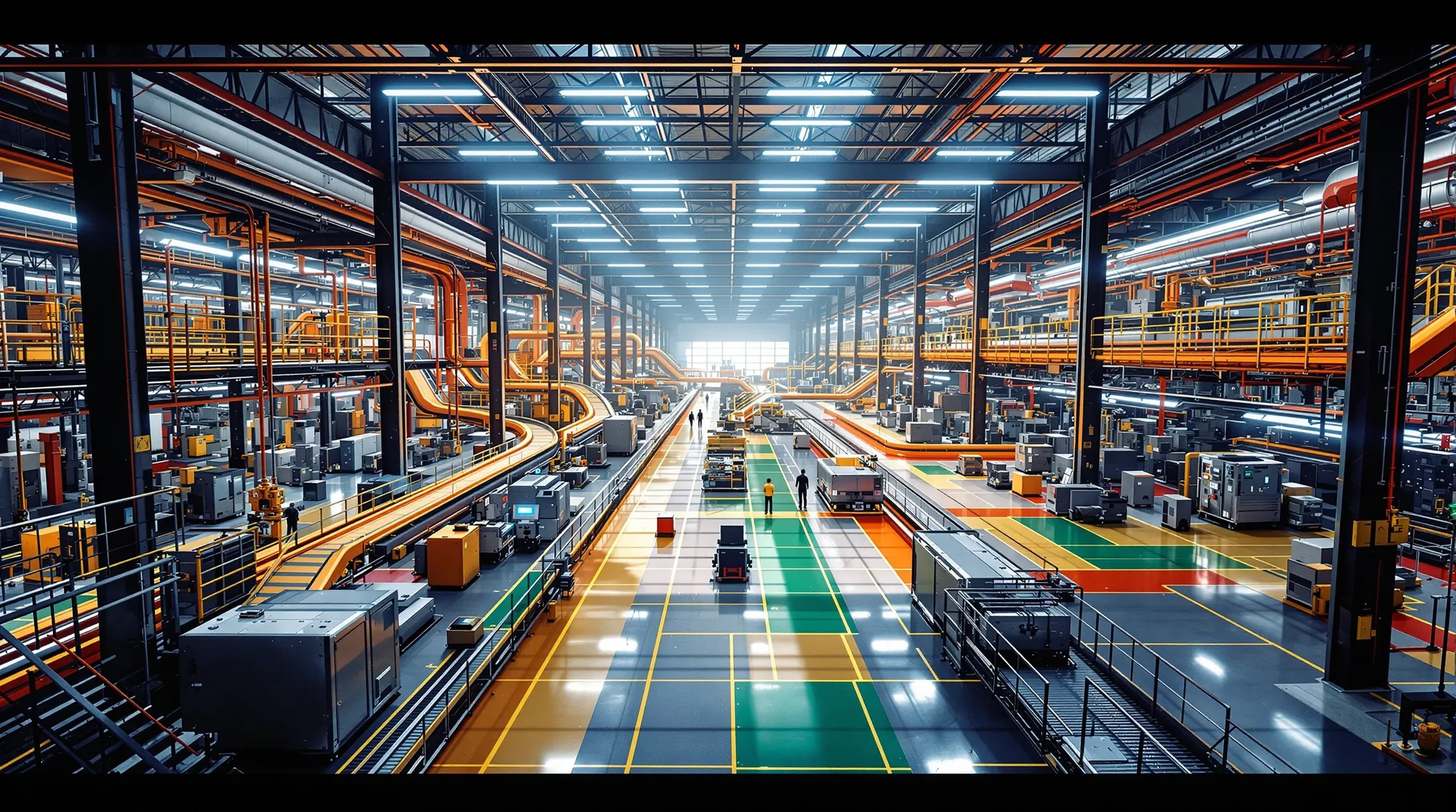Discover how contract manufacturing can revolutionize your business operations and boost competitive advantage in the global marketplace. This comprehensive guide explores the essential aspects of contract manufacturing, from its fundamental principles to strategic benefits.
What is Contract Manufacturing?
Contract manufacturing represents a strategic business arrangement where companies outsource their production to specialized third-party manufacturers. This collaborative model enables businesses to concentrate on core activities like research, design, marketing, and sales while leveraging external manufacturing expertise. In the global marketplace, it has become a fundamental component of modern supply chain management.
This business model offers companies the flexibility and efficiency they need without substantial investments in production facilities, equipment, or specialized workforce. Over recent decades, it has evolved from basic production agreements into sophisticated partnerships encompassing design collaboration, quality control systems, and distribution services.
Definition and Role in the Supply Chain
Contract manufacturing operates as a specialized outsourcing model where a brand owner engages an external manufacturer to produce goods according to specific requirements. The contracting company maintains control over product design, marketing, and sales, while the manufacturer focuses solely on production aspects.
Within supply chain management, contract manufacturers act as vital intermediaries between raw material suppliers and end-product distributors. Their responsibilities include:
- Raw material procurement and management
- Production planning and execution
- Assembly and testing procedures
- Quality control implementation
- Packaging and shipping coordination
Types of Contract Manufacturing
| Type |
Description |
Primary Industries |
| Original Equipment Manufacturing (OEM) |
Produces components or products based on client specifications under the client’s brand name |
Electronics, Automotive, Consumer Goods |
| Original Design Manufacturing (ODM) |
Contributes to product design and owns intellectual property while manufacturing under client’s brand |
Electronics, Consumer Products |
| Contract Manufacturing Organizations (CMOs) |
Specializes in specific industry segments with comprehensive services including development support |
Pharmaceuticals, Biotechnology |
| Private Label Manufacturing |
Produces products for retailers to sell under their own brands |
Food & Beverage, Personal Care |
Benefits of Contract Manufacturing
Contract manufacturing delivers strategic advantages in today’s competitive business environment by enhancing both operational efficiency and financial performance. This approach allows companies to focus on their strengths while accessing specialized manufacturing capabilities.
Cost Efficiency and Scalability
The financial benefits of contract manufacturing extend beyond basic cost reduction. Key advantages include:
- Elimination of capital expenditure on manufacturing facilities
- Reduced operational costs through economies of scale
- Flexible production scaling based on demand
- Lower per-unit production costs
- Improved cash flow management
- Reduced inventory carrying costs
The scalability aspect proves particularly valuable for companies with seasonal products or uncertain demand patterns. For instance, during the 2021 chip shortage, electronics companies leveraged contract manufacturing to adjust production capacity efficiently, avoiding both missed opportunities and excess capacity costs.
Access to Expertise and Technology
Contract manufacturers provide specialized manufacturing expertise that would otherwise require significant investment and time to develop internally. These manufacturing partners excel in production optimization, continuously enhancing their processes and investing in their workforce’s technical capabilities. This specialized knowledge translates into superior production quality, reduced defects, and consistent product output—delivering value far beyond basic manufacturing services.
- Advanced quality management systems
- Sophisticated engineering capabilities
- State-of-the-art equipment access
- Automated testing protocols
- Production analytics implementation
- Precision manufacturing expertise
The technological advantage offered by contract manufacturers is substantial. Industry leaders like Flextronics and Jabil maintain cutting-edge equipment and advanced production technologies that would be cost-prohibitive for individual businesses. Their engineering teams achieve exceptional precision, with some operations maintaining tolerances as precise as ±0.001 inches in cold-formed parts. Industry data indicates that contract manufacturers reduce defect rates by an average of 15% compared to in-house production startups.
Industries Utilizing Contract Manufacturing
Contract manufacturing has evolved into a crucial strategic element across multiple industrial sectors, each leveraging outsourced production to address specific challenges and access specialized capabilities. The global contract manufacturing market shows robust growth, projected at a 7.8% CAGR through 2028, demonstrating increasing reliance on this business model worldwide.
Pharmaceutical Industry
The pharmaceutical sector represents a primary user of contract manufacturing services, with market projections reaching $126.9 billion by 2027. This industry relies extensively on Contract Manufacturing Organizations (CMOs) and Contract Development and Manufacturing Organizations (CDMOs) for specialized production requirements and regulatory compliance.
| Service Type |
Applications |
| API Production |
Active Pharmaceutical Ingredient manufacturing |
| Formulation Development |
Drug composition and delivery systems |
| Clinical Trial Materials |
Research and testing phase production |
| Commercial Manufacturing |
Large-scale production for market distribution |
Electronics and Aerospace
The electronics industry pioneered contract manufacturing, with companies like Foxconn manufacturing approximately 40% of global consumer electronics. This sector leverages contract manufacturers’ capabilities in advanced PCB assembly, surface mount technology, and miniaturization processes.
In aerospace manufacturing, the focus shifts to high-precision requirements and specialized materials processing. The industry relies on contract manufacturers for components ranging from engine parts to composite airframe structures. These partnerships typically involve long-term commitments and require specialized certifications like AS9100, enabling companies like Boeing and Airbus to distribute production risks while accessing global manufacturing expertise.
Risks and Challenges in Contract Manufacturing
While offering numerous advantages, contract manufacturing presents significant challenges that require careful management. Industry studies indicate that approximately 65% of businesses using contract manufacturing experience at least one major quality or delivery issue annually. Successful partnerships demand clear communication channels, defined quality standards, robust intellectual property protection, and comprehensive contingency planning.
Intellectual Property Concerns
Intellectual property (IP) protection stands as a critical challenge in contract manufacturing relationships, with nearly 40% of companies reporting IP security concerns according to a 2022 industry survey. When organizations share proprietary designs, formulations, or technologies with external manufacturers, they face potential risks of IP theft or unauthorized use, particularly in regions with weak IP protection enforcement.
- Comprehensive non-disclosure agreements and IP ownership clauses
- Compartmentalized manufacturing processes for sensitive components
- Digital rights management systems for documentation control
- Physical security measures at manufacturing facilities
- Strategic selection of manufacturers in countries with strong IP laws
- Exclusive manufacturing relationships
Quality Control and Assurance
Quality management presents a significant challenge in contract manufacturing, with 58% of businesses identifying it as their primary concern. The physical separation between company headquarters and manufacturing facilities often complicates quality oversight, potentially impacting regulatory compliance, customer relationships, and brand reputation.
| Quality Management Component |
Implementation Strategy |
| Quality Assurance (QA) |
Process-oriented systems for preventing quality issues |
| Quality Control (QC) |
Product-based testing and defect identification |
| Monitoring Systems |
Real-time quality tracking technologies |
| Performance Metrics |
Clear KPIs for quality measurement |
Building Successful Partnerships with Contract Manufacturers
Strategic partnerships with contract manufacturers significantly influence production success, with collaborative relationships showing 37% fewer quality issues and 42% better on-time delivery rates compared to transactional arrangements. These partnerships require a balance of formal agreements and flexible communication channels to maximize effectiveness.
Criteria for Selecting a Contract Manufacturer
- Technical capabilities and manufacturing expertise
- Quality management systems and compliance history
- Financial stability and business sustainability
- Cultural alignment and communication practices
- System integration capabilities
- Operational excellence standards
- Innovation potential and technological sophistication
The selection process should include comprehensive due diligence, site visits, and production trials when possible. Companies typically narrow their selection to 3-4 finalists before making a final decision, ensuring the chosen partner can support both current manufacturing needs and future growth objectives.
Case Studies and Examples
Apple’s partnership with Foxconn exemplifies the power of strategic contract manufacturing collaboration. This relationship has enabled Apple to maintain exceptional quality standards while achieving remarkable scale, with Foxconn producing over 500,000 iPhones daily during peak periods. The partnership involves custom production techniques and specialized equipment development to meet Apple’s exacting requirements.
- Nike leverages specialized footwear manufacturers across Asia, focusing on design innovation and marketing while benefiting from manufacturing expertise
- Catalent’s collaboration with Moderna during COVID-19 vaccine development compressed technology transfer timelines from months to weeks
- Medtronic partners with precision manufacturing specialists for complex medical device components requiring exceptional quality control
These partnerships highlight essential success factors that companies can adopt across industries:
| Success Factor |
Implementation Impact |
| Clear Quality Expectations |
Consistent product excellence and reduced defects |
| Integrated Planning |
Streamlined production and faster time-to-market |
| Mutual Expertise Respect |
Enhanced innovation and problem-solving |
| Shared Objectives |
Aligned strategic outcomes and sustainable growth |
Future Trends in Contract Manufacturing
The contract manufacturing sector is undergoing rapid transformation, driven by technological advancement and evolving market demands. Industry research indicates that manufacturers investing in advanced technologies and sustainable practices achieve 28% higher client retention rates and 33% better profit margins compared to traditional operations.
Automation in Manufacturing
Automation represents the primary force reshaping contract manufacturing, with 72% of manufacturers increasing their automation investments by at least 15% annually over the past three years. Advanced technologies including robotics, AI, machine learning, and IoT connectivity are revolutionizing production processes, delivering significant improvements:
- Defect reduction rates of up to 85% through automated quality inspection systems
- Real-time production monitoring enabling proactive problem resolution
- Enhanced precision and reduced human error in manufacturing processes
- Optimized workflows and improved production efficiency
- Faster time-to-market and greater production flexibility
Sustainability and Environmental Practices
Sustainability has emerged as a central strategic priority, with 63% of contract manufacturers establishing formal sustainability programs in the past five years. These initiatives deliver dual benefits of environmental protection and business advantage, typically reducing operational costs by 15-30%.
- Energy efficiency improvements and renewable energy adoption
- Waste reduction and water conservation measures
- Sustainable material sourcing initiatives
- Circular economy programs including product recyclability
- Closed-loop material systems implementation
- Remanufacturing program development
FAQs about Contract Manufacturing
Contract manufacturing is a strategic business arrangement where a company outsources the production of its products to a third-party manufacturer. This model enables businesses to concentrate on core competencies like design, marketing, and sales while leveraging specialized manufacturing expertise. The global contract manufacturing market demonstrates robust growth, with projections indicating an 8.5% annual increase through 2027.
| Aspect |
Benefit |
| Operational Flexibility |
Reduced capital investment requirements |
| Agreement Coverage |
Quality standards, timelines, IP protection, costs |
| Ownership Structure |
Client retains design and brand control |
| Manufacturing Support |
Technical expertise and production infrastructure |
Common Misconceptions and Concerns
The contract manufacturing model faces several misconceptions that warrant clarification. Quality concerns often top the list, yet reputable manufacturers maintain rigorous quality management systems that can enhance product standards through specialized expertise.
- Quality Control – Manufacturers implement stringent quality assurance protocols and regular audits
- Production Control – Managed through comprehensive agreements and clear communication channels
- Intellectual Property Security – Protected via legal frameworks and strategic manufacturing approaches
- Communication Challenges – Addressed through structured protocols across time zones
- Dependency Management – Mitigated through strategic partner selection and relationship building
While these concerns require careful consideration and specific management strategies, they shouldn’t automatically disqualify contract manufacturing as a viable business approach. Success lies in developing robust partnerships, implementing clear protocols, and maintaining effective communication channels throughout the relationship.









